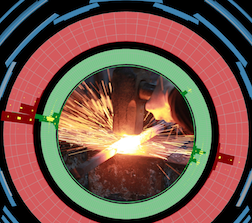A search for supersymmetry with gauge mediated breaking is presented. This search was carried out in pp-collisions with two photons collected by the CMS Experiment at the LHC, CERN at $\sqrt{s}=13$ TeV with integrated luminosity of 2.3 fb^{-1}. The missing transverse energy of the selected events was then compared with the Standard Model background predictions which were determined using a...
We discuss resonant squark production at the LHC via baryonic R-parity violating interactions. The cross section easily exceeds pair-production and a new set of signatures can be used to probe squarks, particularly stops. These include dijet resonances, same-sign top quarks and four-jet resonances with large b-jet multiplicities, as well as the possibility of displaced neutralino decays. We...
A review of the latest results on SUSY searches for stops/sbottoms with the CMS detector with 13 TeV data.
Naturalness arguments for weak-scale supersymmetry favour supersymmetric partners of the third generation quarks with masses not too far from those of their Standard Model counterparts, which would give rise to large production rates at the LHC. Several supersymmetric models also predict massive long-lived supersymmetric particles. If charged,
these might be directly detected through abnormal...
In supersymmetric extensions of the Standard Model, the superpartners of the top quark (stops) play the crucial role in addressing the naturalness problem. For direct pair-production of stops with each stop decaying into a top quark plus the lightest neutralino, the standard stop searches have difficulty finding the stop for a compressed spectrum where the mass difference between the stop and...
Introduction
A minimal U(1)x extension of the MSSM
Bounds on Z'
Impact on stops masses
Conclusions
We study a supersymmetric extension of the MSSM that gives both a dark matter (DM) candidate and contributes to account for the 125 GeV Higgs mass. We show how to achieve excellent $\sim$ 10 % fine-tuning and a thermal relic WIMP DM consistent with all existing constraints, by just adding a pair of SU(2) doublets and a singlet to the MSSM. The main annihilation channels in our model are to...
Current data (LHC direct searches, Higgs mass, dark matter-related bounds) severely affect the constrained minimal SUSY standard model (CMSSM) with neutralinos as dark matter candidates. But the evidence for neutrino masses coming from oscillations requires extending the SM with at least right-handed neutrinos with a Dirac mass term. In turn, this implies extending the CMSSM with right-handed...
